- Home
- T-TRAK Modules and Layouts
Starting with the standards, we will explore basic modules and using them for some basic layout setups. A very basic modules can be used to create a basic home layout. However, there are some very complex modules and module arrangements at large regional and national shows. The T-TRAK format permits the inclusion of these basic units in more complex layouts, thereby allows for modules built as for the starter home layout to be taken to shows and included in more complex setups.
T-TRAK layouts can range from a simple circle to a large complex network of modules. While most layouts consist of multiple ovals it is possible to use T-TRAK modules to run trains in a point to point fashion. This page will cover a few layouts based upon a logical progression of module additions.
The simplest layout consists of a circle. This can be created with either four 90° corners (pictured), two 180° end caps, or an end cap and two 90° corners. It is assumed that at least one of the corner modules includes power drops for both tracks, using Unijoiner power connections as specified in the standards.

Adding a pair of singles to the previous circle layout yields a small oval slightly over 3 feet long.
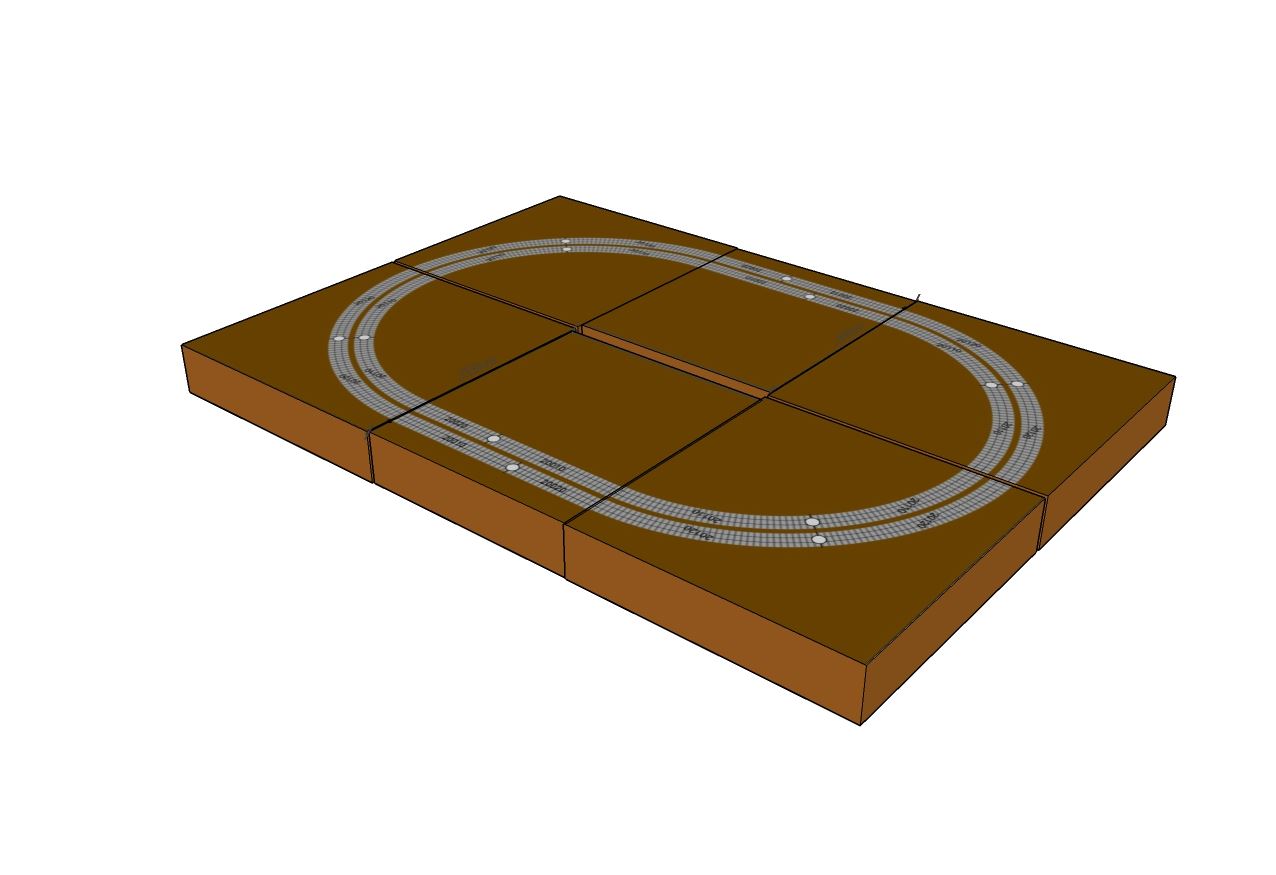 Adding a double to the previous small oval layout yields adds another foot to the size of the oval. Notice that one of the singles was moved to the near side.
Adding a double to the previous small oval layout yields adds another foot to the size of the oval. Notice that one of the singles was moved to the near side.
 Naturally, the expansion of this layout can continue by adding a pair of singles modules to each side. In this picture, the layout has been expanded by adding a double and two singles. The double could easily have been two singles. The length of this layout is slightly over six feet. A good rule of thumb is to connect a power drop approximately every 6-8 "single" units of modules. So if one of the original corner modules included a power drop, the corner diagonally opposed should also have a connected power drop on this layout.
Naturally, the expansion of this layout can continue by adding a pair of singles modules to each side. In this picture, the layout has been expanded by adding a double and two singles. The double could easily have been two singles. The length of this layout is slightly over six feet. A good rule of thumb is to connect a power drop approximately every 6-8 "single" units of modules. So if one of the original corner modules included a power drop, the corner diagonally opposed should also have a connected power drop on this layout.
 Adding an additional 90° corner and an inside corner to the previous module inventory permits the assembly of an L-Shaped layout.
Adding an additional 90° corner and an inside corner to the previous module inventory permits the assembly of an L-Shaped layout.
 Another alternative is to add a pair of T-Junctions to the "6 foot layout" to create three ovals - two inner loops and one outer loop.
Another alternative is to add a pair of T-Junctions to the "6 foot layout" to create three ovals - two inner loops and one outer loop.
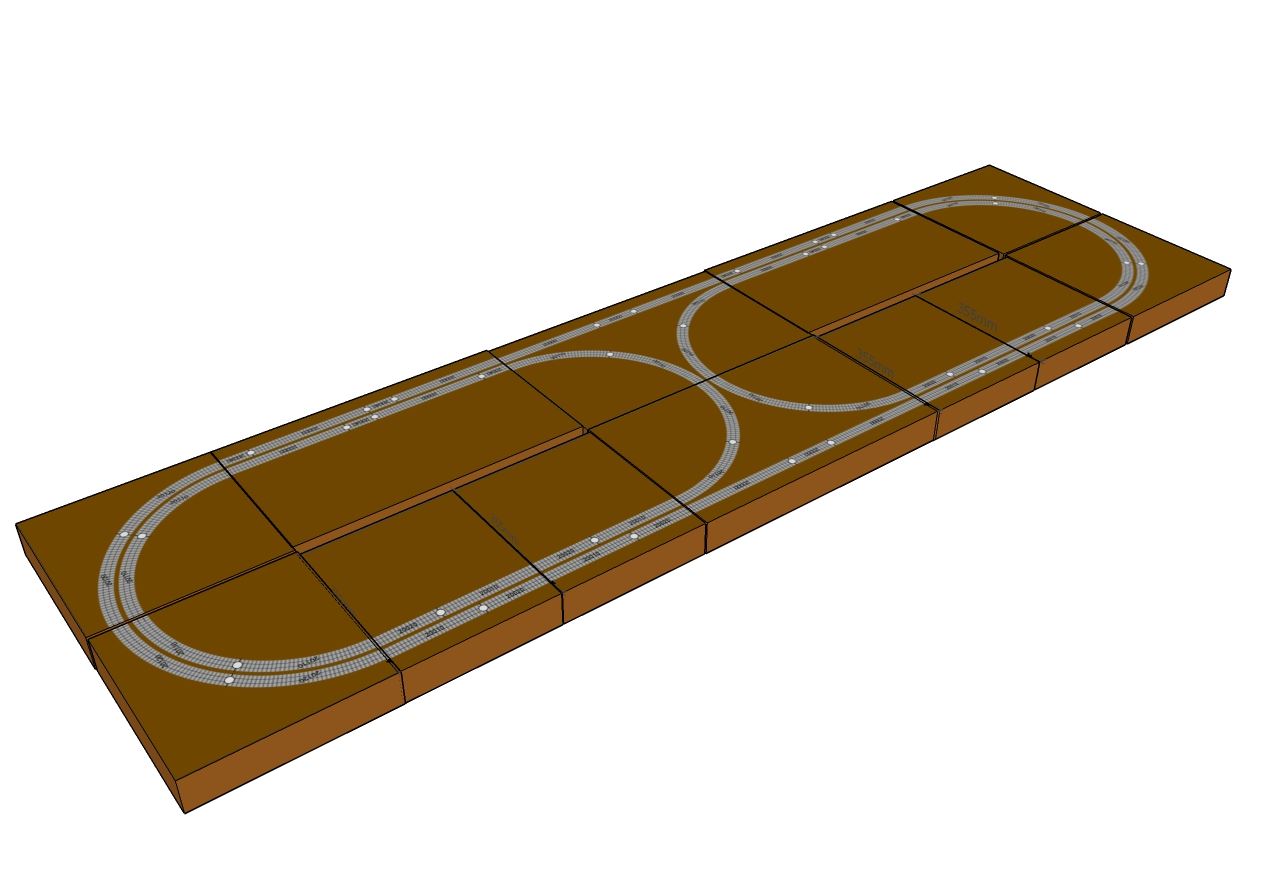 Finally, by adding all of the previous discussed modules together, an L-Shaped, Tri-Oval can be created. There are other configurations that can be created with this modest inventory of modules but those exercises will be left to the reader. Be sure to check the websites in the recommended links section for additional layout designs.
Finally, by adding all of the previous discussed modules together, an L-Shaped, Tri-Oval can be created. There are other configurations that can be created with this modest inventory of modules but those exercises will be left to the reader. Be sure to check the websites in the recommended links section for additional layout designs.
The minimal standards in T-TRAK permit the flexibility to build modules of all shapes and sizes; however, there are some basic modules that are common building blocks for most layout. T-TRAK modules fall into three main categories: straights, corners, and junctions. Pictured to the right is a single. Single modules are 308 mm wide with 310 mm of track. The track arrangement is usually a 186 mm and a 124 mm section for each line or a 248 mm and a 62 mm.
 Track needed: 2 Kato 20020 and 2 Kato 20010
Track needed: 2 Kato 20020 and 2 Kato 20010
The double module is 618 mm wide with 620 mm of track (double the track length of a single). Track arrangement for the double can be accomplished with two pieces each of 186 and 124 mm track sections (for each line). It can also be built with two pieces each of 248 and 62 mm track. Another common arrangement for doubles is using two pieces of 248 mm and one piece of 124 mm for each line. As previously stated, any arrangement which yields 620 mm of track for each line is acceptable.
 Track needed: 4 Kato 20000 and 4 Kato 20040
Track needed: 4 Kato 20000 and 4 Kato 20040
The triple module is 928 mm wide with 930 mm of track (triple the track length of a single). Track arrangement for the triple can be accomplished with numerous ways as long as track length for each line is 930 mm of track. Obviously, it can be accomplished using three times the pieces required for a single.
Longer modules can be created but often it is easier to construct a set of smaller, standard-sized modules to depict the desired scene. Using this technique, long sidings or yards can be constructed and still remain portable.
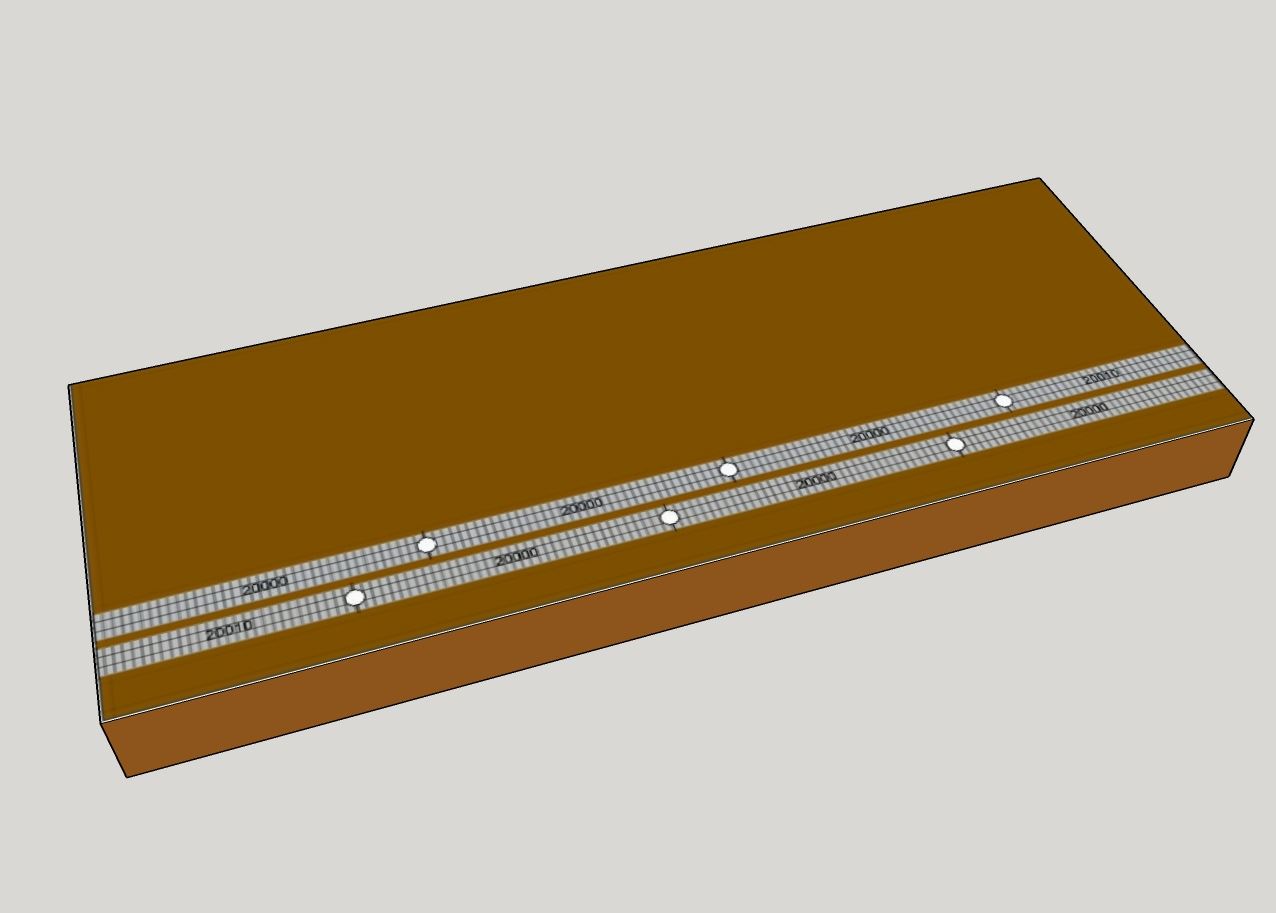 Track needed: 6 Kato 20000 and 2 Kato 20010
Track needed: 6 Kato 20000 and 2 Kato 20010
The most common 90° corner consists of a module 365 mm long on each side. Track consists of two pieces of 282 mm radius and two pieces of 315 mm radius. These radii permit a double row of modules on a single folding table.
 Track needed: 2 Kato 20110 and 2 Kato 20120
Track needed: 2 Kato 20110 and 2 Kato 20120
The 180° corner, also known as an end cap, measures 365 mm in length and 730 mm in depth. It functionally replaces two 90° corners and requires four pieces of 282 mm radius and four pieces of 315 mm radius. While end caps are convenient in that they reduce the number of modules, using them exclusively limits layout designs to ovals.
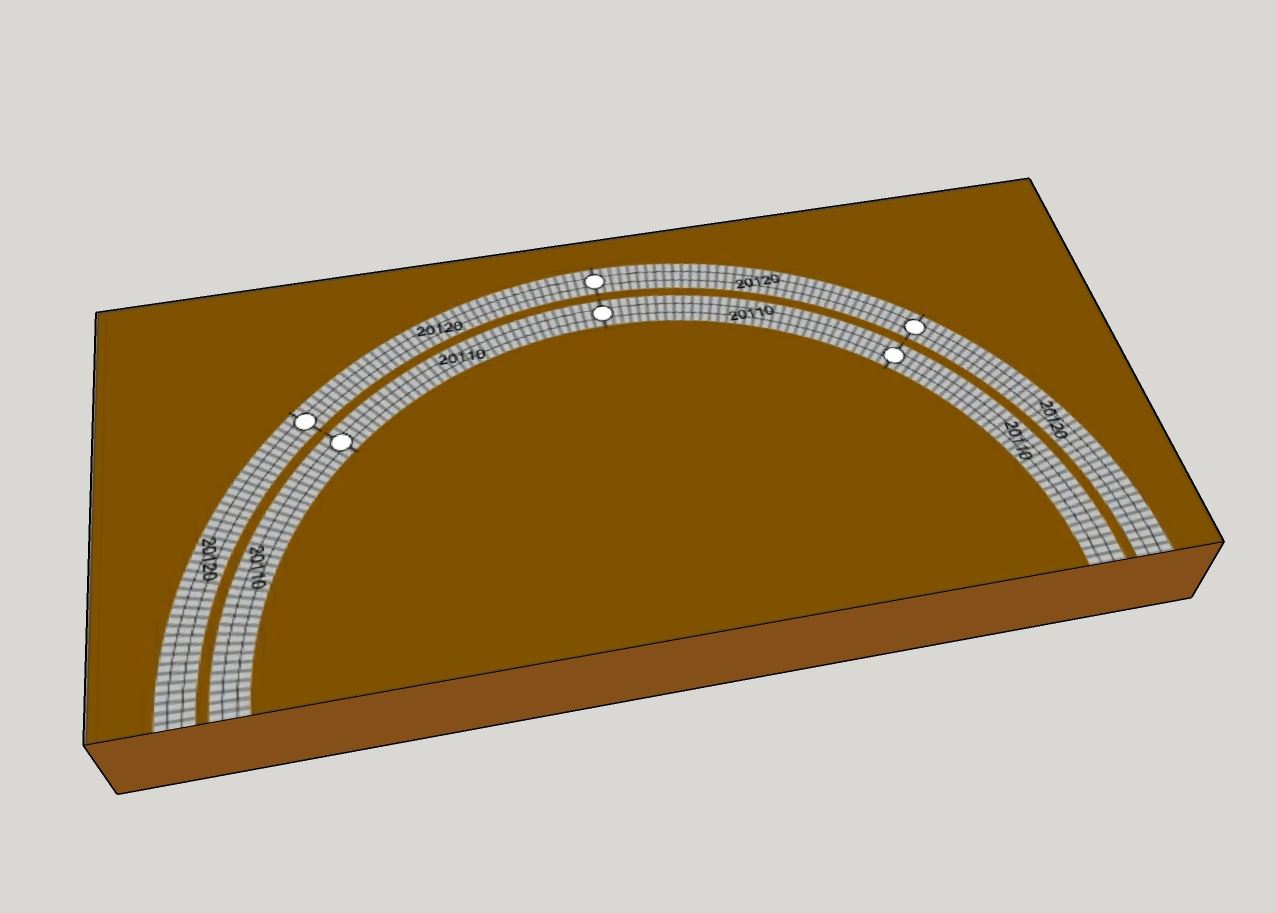 Track needed: 4 Kato 20110 and 4 Kato 20120
Track needed: 4 Kato 20110 and 4 Kato 20120
The inside corner is not as common as other module types but is required for L-shaped layouts that consist of a double row of modules. Refer to The Unofficial T-TRAK Handbook for module dimensions as they can vary depending on the depth of straight single modules. However, as a rough rule and assuming standard radii corners and 33 mm track spacing, an inside corner module with square dimensions greater than 410 mm and less than 675 mm should work for a base module. Track placement will not necessarily be aesthetically correct but it will fit. There are two known working track configurations for an inside module. One configuration is the the same as the 90° corner with the addition of a 29 mm track piece between the two 45° track pieces. The other configuration consists of two 30° 348 mm radii easement pieces to two 15° 315 mm radii pieces for the inner (Yellow) line. The outer (Red) line consists of two 15° 315 mm radii plus two 15° 282 mm radii plus another two 15° 315 mm radii.
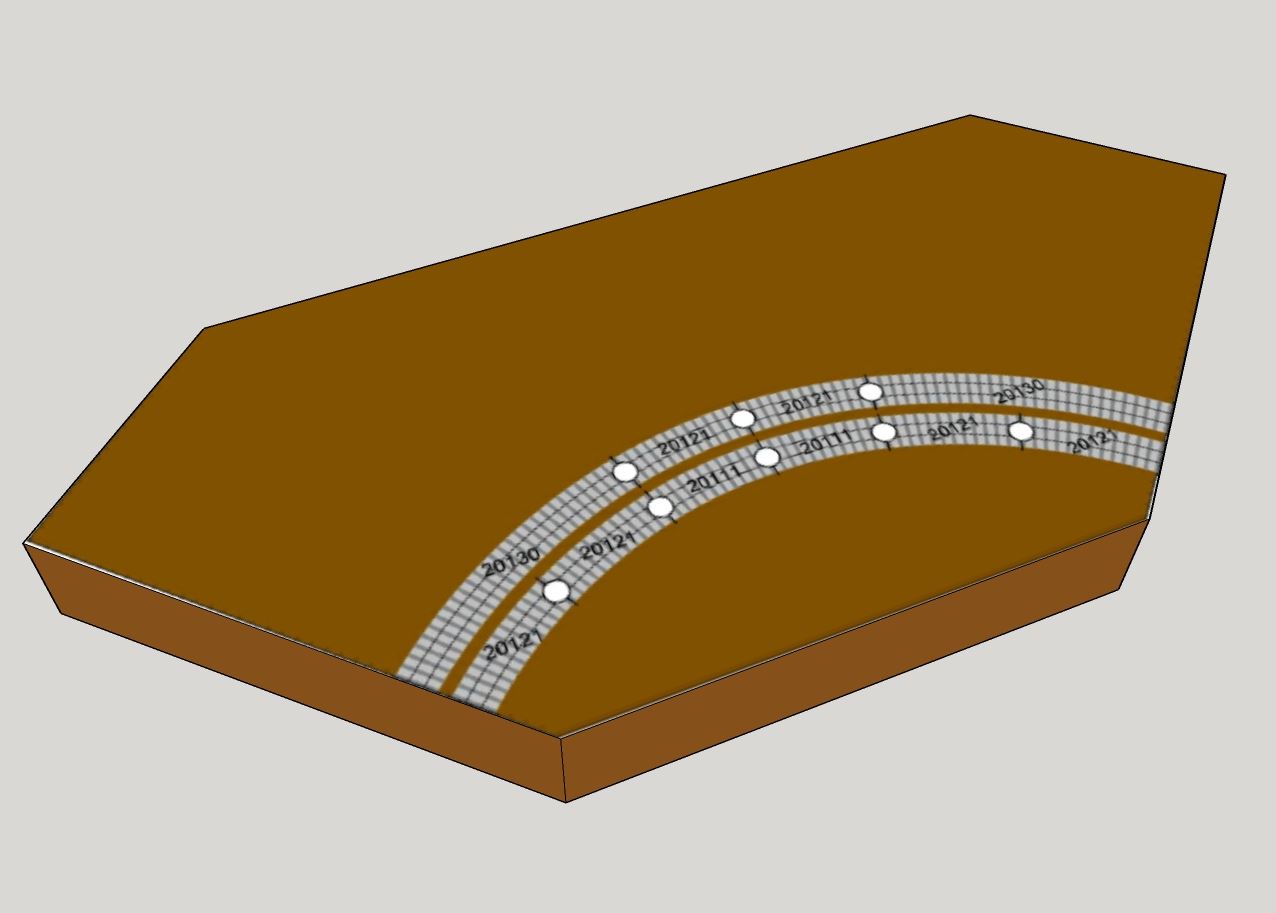 Track needed: 2 Kato 20130, 6 Kato 20121, and 2 Kato 20111
Track needed: 2 Kato 20130, 6 Kato 20121, and 2 Kato 20111
The T-Junction is a special module but has become very common in larger layouts as it permits more complex module arrangement as well as increasing the number of loops on a layout. The geometry of the T-Junction was derived by Steve Jackson in 2004 based on the geometry of a typical corner. The track of the T-Junction consists of four pieces of 45° 282 mm radius track for the two inner curves. The straight track is 597 mm in length. This is not a standard length for Kato Unitrack so either requires their special expansion track or cutting track to the appropriate length. The expansion track between two 248 mm pieces are depicted in the picture at right.
 Track: 4 Kato 20110, 2 Kato 20000, and 1 Kato 20050 (click image to enlarge)
Track: 4 Kato 20110, 2 Kato 20000, and 1 Kato 20050 (click image to enlarge)
Detailed information regarding electrical connections techniques, other than the standard wiring polarity and the use of Kato connectors, as well as various module construction methods, can be found on The Official T-TRAK Standards and The Unofficial T-TRAK Handbook.
